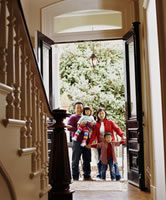Moving with Kids: After the Move
Moving Tips : Moving with Kids
Moving advice, moving activities & moving resources for Moving with Children of all ages.
After The Move

Moving Advice: Settling In
You’re done with closing and have moved into your new home, but you’re not finished — in fact, your new life is just beginning! There’s more to do on the family front to make your house truly a home.
After the tiring and seemingly neverending chores of planning, sorting, and packing, this is the fun part of family moving — settling into your new home! It’s when the adventure begins for your kids in their new home and new neighborhood, as they discover all kinds of wonderful surprises in their new place. Here are some useful moving in settling in tips for moving kids into the new home, making new friends, as well as other important ways to ensure a happily-ever-after ending to your family’s move.
After the move, be prepared to re-teach household rules to young children and toddlers in the new home, like not touching what is hot.
More than ever, monitor your kids’ moods after the move. Children can have trouble sleeping in an unfamiliar room after a move, or they can be teary or cranky. When kids had originally seemed excited about moving, the sudden change in attitude after having moved in can be alarming. However, this is not unusual. Give your children time and be sensitive to their emotions. It won’t be long before they settle in for good, and they’re sure to make exciting surprises and new friends that will have them smiling once again!
Prolonged upset or moodiness after a move shouldn’t be ignored. Unusual problems with schoolwork or dealing with peers, or changes in sleeping/eating patterns that don’t get better are possible signs that your child may need extra support in adjusting to the move.
10 Tips to Settling in Your Home Sweet Home
1) Make a positive goodbye to your old home and community.

One of the best tips for family moving is letting go and moving forward to your new life on a positive note. Taking-leave rituals will help provide a sense of closure in your old home, which will make the transition easier for your kids when settling into the new home and new community. Here are some “saying farewell” ideas:
- A few weeks before you move, hold an informal get-together for close friends and neighbors to say farewell.
- As a family, make a point of visiting favorite restaurants and other special places one more time before you leave.
- When everything’s been packed away and the old house is empty, take a room-by-room “memory walk” with your children. Recall birthday parties in the dining room, holiday events in the living room, stories of bringing the children home as babies –the kinds of memories every family has. Take a last stroll around the outside too.
- Compare how the house feels empty to how it felt with all your belongings there. Doing this, your children will get the idea that what really makes a home is the family and your personal things – framed pictures, furniture, dishes, books, toys.
2) Plan a family welcoming ritual for your new home.

Welcome rituals can be anything that will have meaning for your children and you. Here are some ideas for your “new home welcome rituals”:
- If the children are seeing the house for the first time, do a walk-through together to “meet” your new home before your things fill the rooms.
- Plant a tree or bush together outside as a symbol that this is your home now. If it’s wintertime, plant something in a pot inside that you can transplant in the spring.
- Gather together to hang a family photograph or find the perfect spot for an object that is special to your family. If you’ve always had a fountain, bird feeder, or a swing in the backyard, make a special event of putting the new one up in this home together.
3) Have everyone’s “basic survival necessities” where you can find them immediately and easily in the new home.

These “survival necessities” may be baby’s “blankie”, favorite pajamas for your toddler, essential music CD or comfy sweatshirt for your teen, and the coffee pot for you. Pack a suitcase or box with “must haves” for each family member — belongings that would cause crankiness, crying, or raise blood pressure if they went missing for too long. Your first few days in your new home, especially that first night and morning, will be so much more pleasant for the family when everyone has the familiar stuff that make them comfortable.
4) Re-establish regular family routines, such as mealtimes and bedtimes, right away.

When moving, there’s a certain amount of disruption to regular schedules that you simply can’t avoid. But once you’ve moved in, aim to get back on track with your normal family routines as quickly as possible. This will help younger children, in particular, who need routines and more consistency. This also sends the important message to all members that you are the same family, just in a new setting. The old rules, routines and rituals still apply no matter where you’re at.
5) Be sure to prioritize the unpacking process.

You certainly didn’t pack in a day, so don’t try to unpack in one either. Make setting up the children’s bedrooms your first priority to help get them comfortable. Put the kitchen, bathroom(s), family room and other high-use living spaces at the top of the list. Don’t obsess over decorating or hanging pictures right away. Take your time to enjoy getting to know your new home and the wonderful discoveries you and your kids will make about it.
6) Allow the children some say in setting up their new bedrooms.

Their new bedroom is truly their own space in the new home, so let your kids claim it. Of course, your children’s age will depend on how much control they have. At the least let them decide where their bed goes in the room. If there’s a budget for new furnishings, let them help select the new rug or bedspread, or allow them to select a few bedroom decorations of their own such as removable wall stickers.
7) Help your kids feel comfortable in their new bedrooms.

Some kids have trouble sleeping in a new bedroom. It is unfamiliar to them and can make them feel anxious. Take the time to talk about how this bedroom is similar to the child’s old room and also discuss how it’s different. Pay special attention to bringing in furnishings and belongings that were in the old room to encourage a sense of familiarity. Bring up things about the old room that your child didn’t like, such as weird shadows or rattling windows, and help your kid discover the good things about this new bedroom.
8) Familiarize yourselves with the new neighborhood.

This is especially important for comfort and safety. You want your children to know as quickly as possible the boundaries of where they can go and where they can’t go beyond. Taking walks or driving around together as a family is the best way to uncover the exciting surprises that await in the new neighborhood.
9) Help your family pets settle in.

Your children will feel more comfortable when they see that their family pets are doing okay. Cats do best when you confine them to one room in the new house. Give your pets opportunities to explore further, but don’t push. As they feel more comfortable, they’ll expand and explore their new territory. Keep dogs on a leash until they get to know the new neighborhood. In general, don’t let cats or dogs roam around the new place immediately. The last way you want to meet the neighbors is through a door-to-door search for your little pooch or feline!
10) Remember to “make new friends but keep the old.”

Play an active role in helping your children make new friends in your new community. However, do also support their need to hold onto their old friends. They will appreciate having you as their confidante for sharing their new experiences and discoveries.
Helping your kids meet new friends:
- With new colleagues from work or new families you meet, set up play dates for younger children to get to know each other.
- Find activities for your school-age children to join, such as sports teams, clubs, lessons and classes. Meeting children with the same interests as your child increases the odds of going beyond acquaintance to friend.
- Take the initiative and introduce yourself to the neighbors. Your children’s first new friends may literally be living next door. A meet-and-greet can help get those new friendships get underway.
- Staying in touch with old friends
- Pre-paid phone cards can keep long distance calls to old friends from breaking your budget.
- Make plans for an upcoming visit with old friends — whether in the new neighborhood or the old.

